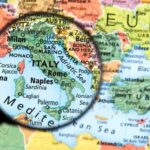As the world continues to navigate the challenges brought about by the COVID-19 pandemic, travel restrictions and guidelines have become a top concern for those planning international trips. For US citizens considering a visit to Italy, it is essential to stay informed about the current restrictions in place. From COVID-19 protocols and entry requirements to transportation and cultural considerations, there are several factors to take into account when planning a trip from the US to Italy.
The first section of this article will provide a brief overview of the current travel restrictions and guidelines for US citizens traveling to Italy. This includes important information such as COVID-19 testing and vaccination requirements, any quarantine measures, as well as health protocols that travelers must adhere to upon arrival in Italy.
In addition to COVID-19 protocols, US citizens will also need to be aware of entry visa and documentation requirements for traveling to Italy. The article will cover necessary entry visas and documentation, along with any additional requirements such as travel insurance or health declarations. It will also provide insight into any specific travel restrictions or limitations for US citizens traveling to Italy, including restricted areas or activities that may be off-limits.
COVID-19 Protocols and Requirements
Traveling to Italy from the US during the COVID-19 pandemic requires careful consideration of the protocols and requirements in place. Whether you are vaccinated or not, there are specific guidelines that travelers must follow to ensure a smooth and safe journey. Here is a breakdown of the COVID-19 protocols and requirements for US citizens traveling to Italy:
- COVID-19 Testing: All travelers from the US to Italy must present a negative COVID-19 test result taken within 72 hours before arrival.
- Vaccination Requirements: While vaccination is not mandatory for entry into Italy, being fully vaccinated can exempt travelers from certain testing and quarantine requirements.
- Quarantine Measures: Unvaccinated travelers are required to undergo a 5-day quarantine upon arrival, with the option to end it early with a negative test taken after day 5.
In addition to these protocols, it is important for travelers to stay updated on any changes or additions to the requirements as they plan their trip. It is also recommended to check with airlines and local health authorities for any additional guidelines.
Ensuring that you have all the necessary documentation for your trip is crucial when traveling from the US to Italy during the pandemic. In addition to your passport, here are some essential entry visa and documentation requirements:
- Entry Visa: As a US citizen, you do not need a visa for short stays in Italy (up to 90 days), but longer stays or other travel purposes may require a visa application.
- Additional Requirements: Travelers should be prepared to provide proof of accommodation, travel insurance, and a completed health declaration form upon arrival in Italy.
By ensuring that you have all the necessary visas and documentation in order, you can avoid any complications or delays during your travels. It’s also important to regularly check official government websites and reliable sources for any updates on entry requirements and travel restrictions for US citizens traveling to Italy. This will help you stay informed about any changes that may affect your trip.
Entry Visa and Documentation
When traveling to Italy from the US, it is important for US citizens to be aware of the necessary entry visas and documentation required for their trip. Here are some key points to consider:
- Entry Visas: US citizens traveling to Italy for tourism or business purposes do not need a visa for stays of up to 90 days within a 180-day period. However, if the visit exceeds 90 days, a visa may be required. It’s important to check the latest visa regulations and requirements on the official website of the Italian consulate or embassy in the US.
- Passport: A valid passport is essential for entering Italy. It should be valid for at least three months beyond your planned departure date. Check your passport’s expiration date before traveling, and if needed, renew it well in advance of your trip.
- Additional Documentation: While traveling to Italy, especially during the COVID-19 pandemic, travelers may be asked to provide additional documentation such as a completed health declaration form or proof of accommodation reservations. It is also recommended to carry a copy of your travel insurance policy and any necessary medical documents.
By being prepared with the proper entry visas and documentation, US citizens can ensure a smooth and hassle-free entry into Italy. Remember that requirements may vary depending on the purpose of travel and individual circumstances, so it’s important to stay informed about any updates or changes in regulations.
For up-to-date information and official guidelines regarding entry visas and documentation for US citizens traveling to Italy, it is advised to check with the official website of the Italian embassy or consulate in the United States. Additionally, travel advisories from the U.S. Department of State can provide valuable information on entry requirements and travel alerts specific to Italy.
Travel Restrictions and Limitations
Italy has implemented specific travel restrictions and limitations for US citizens traveling to the country. As of the current guidelines, travelers from the US are allowed to enter Italy for tourism, business, or study purposes. However, there are some limitations and requirements in place that visitors must be aware of before planning their trip.
One of the major restrictions is related to which US states are permitted to travel to Italy. While US citizens are generally allowed entry, admittance may vary depending on the specific regional regulations within Italy and any travel advisories that may be in effect. Additionally, travelers should anticipate potential restrictions on certain types of activities or events, such as large gatherings or cultural attractions.
In response to the ongoing COVID-19 pandemic, there are also health-related limitations and protocols that US citizens must adhere to when traveling to Italy. This includes requirements for COVID-19 testing prior to arrival, as well as potential quarantine measures based on individual circumstances and screening results. Visitors should stay updated on the evolving situation and regularly check official sources for the latest travel advisories and public health guidelines.
| Travel Restrictions | Limitations |
|---|---|
| Admittance from specific US states | Potential restrictions on certain activities |
| COVID-19 testing requirements | Potential quarantine measures |
Transportation and Accommodation Considerations
As US citizens prepare for travel to Italy, there are several important considerations to keep in mind when it comes to transportation and accommodations. In terms of transportation, travelers should be aware that Italy has implemented various restrictions and guidelines to prevent the spread of COVID-19. For example, public transportation may have capacity limits, mask mandates, and specific health protocols in place. It’s advisable for travelers to check the latest regulations and plan their transportation accordingly.
When it comes to finding accommodations, US citizens should seek out lodging options that prioritize health and safety. Many hotels and rental properties have implemented enhanced cleaning procedures and social distancing measures. Travelers may also want to consider staying in less crowded areas or opting for private accommodations to minimize contact with others. Additionally, some cities or regions in Italy may have specific regulations regarding tourism, so it’s important for travelers to stay updated on any local restrictions.
In addition to COVID-19-related considerations, travelers should also take into account the usual aspects of transportation and accommodation when visiting Italy. From researching different modes of transportation (such as trains, buses, or rental cars) to finding suitable lodging options (hotels, hostels, vacation rentals), careful planning can contribute to a smoother travel experience.
By staying informed about both COVID-19 protocols and traditional travel logistics, US citizens can better navigate their transportation and accommodation needs during their trip to Italy.
| Transportation Considerations | Accommodation Considerations |
|---|---|
| Check the latest regulations for public transportation | Look for lodging options with enhanced cleaning procedures |
| Consider capacity limits and mask mandates | Seek out private accommodations if possible |
| Stay updated on any local travel restrictions | Research options in less crowded areas |
Cultural Considerations and Protocols
When traveling to Italy from the US, it is important for tourists to be mindful of cultural considerations and protocols, especially in light of COVID-19 restrictions. Italy has a rich cultural heritage and certain social protocols that visitors should be aware of in order to show respect and avoid any misunderstandings during their stay.
Etiquette and Customs
Italy is known for its strong emphasis on etiquette and customs, including greetings, dining etiquettes, and appropriate dress codes. It is customary to greet people with a handshake and maintain eye contact during conversations. When dining at restaurants, it is polite to wait for all members of your party before starting the meal. Additionally, modest attire is recommended when visiting religious sites or participating in traditional events.
Respect for Cultural Sites
Italy boasts countless historical and cultural sites that hold significant value to its people. Visitors should always show respect when visiting these locations by following any specific rules and regulations outlined by the site management. This may include restrictions on photography, dress codes, or designated pathways to follow when exploring the area.
Adherence to COVID-19 Guidelines
In response to the ongoing pandemic, it is crucial for travelers to adhere to the COVID-19 guidelines in place in Italy. This includes wearing masks in indoor public spaces, maintaining social distancing measures, and adhering to any capacity limits at attractions or events. It’s also important to familiarize oneself with any specific health protocols implemented by individual businesses or venues.
By being mindful of these cultural considerations and protocols, US travelers can have a more enjoyable and respectful experience during their visit to Italy while also demonstrating awareness of local customs and current health guidelines.
Resources for Staying Informed
Staying updated with the latest travel restrictions and guidelines is crucial for US citizens planning to visit Italy. Here are some reliable resources for staying informed:
Official Government Websites
One of the most dependable sources for accurate and up-to-date information on travel restrictions and guidelines for traveling to Italy from the US are official government websites. The U.S. Department of State and the Embassy of Italy in the United States provide detailed updates on entry requirements, COVID-19 protocols, and any specific travel restrictions that US citizens need to be aware of before planning their trip.
Travel Advisory Websites
In addition to government websites, travelers can also refer to reputable travel advisory websites for comprehensive information on travel restrictions and guidelines. Websites such as the Centers for Disease Control and Prevention (CDC) offer country-specific travel recommendations, including health advisories, entry requirements, and COVID-19 protocols for international travelers heading to Italy from the US.
Airline and Travel Agency Updates
For real-time updates on transportation-related guidelines and travel restrictions, individuals planning a trip to Italy can stay informed through their airline carriers or travel agencies. Airlines often provide detailed information on pre-travel testing requirements, documentation needed for entry into Italy, as well as any specific protocols passengers must follow during their journey. Travelers can also consult with their respective travel agencies regarding any changes or updates pertaining to travel restrictions when planning their itinerary.
Conclusion
In conclusion, traveling to Italy from the US requires careful planning and adherence to COVID-19 protocols and requirements. As of now, US citizens must meet specific testing and vaccination criteria, as well as potentially adhere to quarantine measures upon arrival. It is important for travelers to stay informed about any updates or changes to these requirements, as they may evolve in response to the ongoing pandemic.
Additionally, US citizens traveling to Italy should make sure they have the necessary entry visas and documentation in place before their trip. This may include travel insurance and health declarations, so it is essential to thoroughly research and prepare for these requirements in advance. Being proactive about meeting these entry criteria will help ensure a smoother travel experience.
Overall, while there are certain restrictions and limitations in place for US citizens traveling to Italy, careful planning and attention to detail can help facilitate a successful trip. It is also important for travelers to be mindful of cultural protocols and any specific guidelines related to transportation and accommodation. By staying informed and remaining flexible with their plans, US citizens can navigate these travel restrictions and have an enjoyable experience in Italy.
Frequently Asked Questions
What is required for a US citizen to visit Italy?
For a US citizen to visit Italy, they are required to have a valid passport that is at least valid for the duration of their stay. Additionally, they may need to obtain a visa depending on the purpose and length of their visit.
It’s also important to review any specific entry requirements or restrictions that may be in place at the time of travel.
Are there Covid restrictions to travel to Italy?
Yes, there are Covid restrictions for traveling to Italy. Currently, travelers from the United States must either present a negative Covid-19 test result taken within 72 hours before entering Italy or undergo quarantine upon arrival. Travelers may also face health screenings and temperature checks at airports and other entry points.
What is the current travel advisory for Italy?
The current travel advisory for Italy varies based on the region and specific circumstances. The U.S. Department of State provides specific advisory levels for different regions within Italy, based on factors such as crime rates, natural disasters, civil unrest, and public health concerns.
As of now, travelers are urged to exercise increased caution in certain areas due to Covid-19 restrictions and safety concerns. It’s important for visitors to regularly check for updates on travel advisories before planning a trip to Italy.

I’m a passionate traveler, writer, and Italophile. My fascination with Italy’s history, art, and culture has led me on countless adventures across the Italian landscape. Through “I Live Italy,” I share my love for this extraordinary country and aims to inspire others to explore its boundless beauty.




